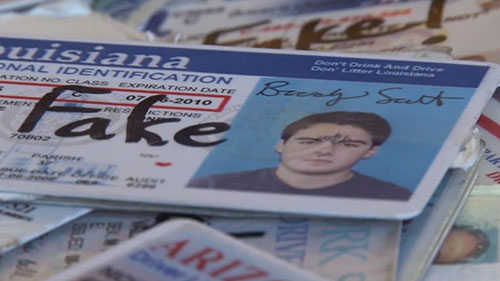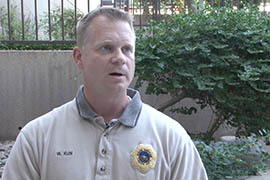Cronkite News has moved to a new home at cronkitenews.azpbs.org. Use this site to search archives from 2011 to May 2015. You can search the new site for current stories.
State program traces sources of liquor provided to those underage
PHOENIX – On a Saturday night in March 2014, 18-year-old Arizona State University student Naomi McClendon was drinking with friends at a fraternity party in Tempe.
When friends took McClendon to a nearby apartment to rest, she was slurring her words. Left alone, McClendon later made her way to the balcony, lost her balance and fell 10 stories to her death.
Tempe determined her fall to be an accident, but for the investigators of the TRACE program, the case was far from closed.
TRACE, or Target Responsibility for Alcohol Connected Emergency, is the investigation unit of the Arizona Department of Liquor Licenses and Control. The investigators are called when underage drinking is involved in a serious accident or death, and their job is to work backward from the time of the incident to find out who supplied the alcohol.
Suppliers can be family, friends or an establishment like a grocery store or bar.
In McClendon’s case, TRACE identified five individuals liable for supplying the vodka she drank that night.
TRACE is modeled after a program used in California, and McClendon’s case is just one of Arizona’s 65 cases opened since TRACE started 10 years ago.
Sgt. Wes Kuhl, the lead investigator for the program since its inception, said many of the cases are tragic and that those involving deaths stand out.
“These are young people who are trying to start a life, start to go to college and be a productive citizen in our state,” he said. “So when we lose somebody like that, it’s hard on us, it’s hard on the family, it’s hard on everybody.”
Kuhl noted that even though these individuals have made the choice to drink, placing responsibility on the people or establishments supplying that alcohol is a key component to reducing underage drinking.
“It’s important because the family member or friend that provided the alcohol to the underage person still did something illegal,” he said. “We are still police officers in the state of Arizona, and so we have to conduct our investigation criminally and hold those people responsible that did commit a crime.”
Lee Hill, communications and special projects director for the department, said TRACE is a valuable prevention tool. When more people know that a program like this exists, it can deter people from supplying underage individuals alcohol in the first place.
“The reason TRACE has been so effective is that people now know that because of surveillance, because of interviewing, because of all these different techniques that we use in this type of an investigation we can very successfully get back to who supplied that liquor,” she said.
These techniques can include gathering information from the site of the incident that can be receipts, fake IDs, grocery bags and interviews with those involved. If the evidence leads leads to an establishment, investigators can issue subpoenas or search warrants to obtain anything else that could help.
TRACE is just one way Arizona focuses on reducing underage drinking.
Before a new semester begins at ASU, Tempe Police Department’s Safe and Sober campaign in part aims to educate as many of the 10,000 incoming freshmen as possible about the dangers of alcohol and the department’s zero tolerance policy with underage drinking. In the following weeks, police heavily patrol for violators.
Lt. Mike Pooley of Tempe police said that even though programs like Safe and Sober and TRACE can’t eliminate underage drinking the consequences need to be echoed, especially to students.
“We hope to avoid seeing anyone hurt,” he said. “When they go to ASU, we want them to get a good education, have fun. But at the end of the semester, at the end of their schooling, we want them to be able to go home safely.”
Arizona establishments recently began denying alcohol to anyone presenting a vertical ID because of a new state law requiring those 21 and over to switch to a horizontal version.
Matthew Bannon, manager of Tops Liquors in Tempe, said his store has had the occasional invalid ID come through its doors. He said his staff is good about spotting violators but added that the ID flip won’t alleviate the problem.
“In the short term it will befuddle a few people attempting to acquire alcohol illicitly,” he said. “In the long run, no. It’s just going to be another convoluted step in a series of underage drinking.”
For the investigators at TRACE, however, every step counts.
“We’re out there. We’re going to be looking for underange people drinking,” Kuhl said. “But when there are tragic incidents that do happen we’re going to be there to trace back the event and hold those people responsible.”









